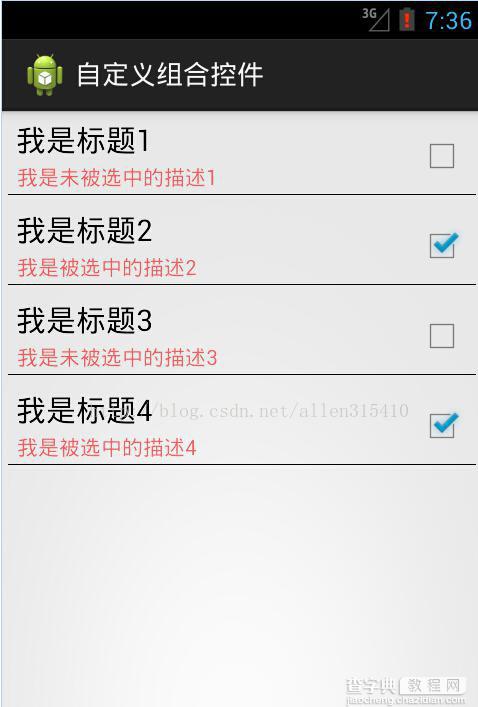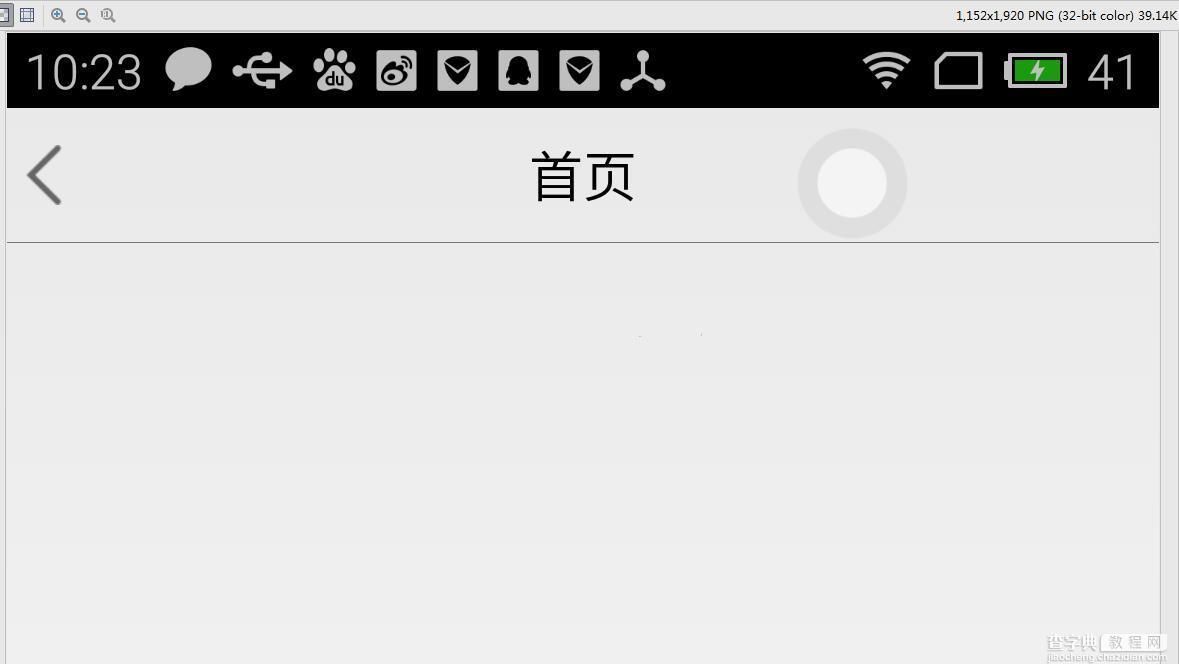有很多情况下,我们只要运用好Android给我提供好的控件,经过布局巧妙的结合在一起,就是一个新的控件,我称之为“自定义组合控件”。
那么,这种自定义组合控件在什么情况下用呢?或者大家在做项目时候会发现,某些布局会被重复的利用,同一个布局的XML代码块会被重复的复制黏贴多次,这样会造成代码结构混乱不说,代码量也会增大,各种控件都需要在Java代码中被申明和处理相应的逻辑,工作量着实不小,所以,必须要找到一个合理的“偷懒”的方式,开动脑经去怎么简化以上说的不必要的麻烦。下面看一张图,就一个简单的布局,我们就此图来实现一个简单的自定义组合控件。

从上面的图来分析,我们可以看到,这个布局里面是没有“全新”的控件的,用的都是Android系统原生的控件。熟悉Android界面布局的人,肯定觉得这种布局真是小Case,太简单了,分分钟就可以写完。于是下面就是某一个条目的布局代码:
<> <relativelayout android:background="@drawable/selector_blue" android:id="@+id/rl_show_address" android:layout_height="60dip" android:layout_width="match_parent" xmlns:android="http://schemas.android.com/apk/res/android"> <textview android:id="@+id/tv_title" android:layout_height="wrap_content" android:layout_marginleft="5dip" android:layout_margintop="1dip" android:layout_width="wrap_content" android:text="这是标题" android:textcolor="#000000" android:textsize="20sp"> <textview android:id="@+id/tv_desc" android:layout_below="@id/tv_title" android:layout_height="wrap_content" android:layout_marginleft="6dip" android:layout_margintop="1dip" android:layout_width="wrap_content" android:text="这是描述内容" android:textcolor="#99ff0000" android:textsize="14sp"> <checkbox android:clickable="false" android:focusable="false" android:id="@+id/cb_status" android:layout_alignparentright="true" android:layout_centervertical="true" android:layout_height="wrap_content" android:layout_width="wrap_content"> <> <view android:background="#000000/" android:layout_alignbottom="@id/cb_status" android:layout_alignparentbottom="true" android:layout_height="0.2dip" android:layout_margintop="7dip" android:layout_width="match_parent"> </view></checkbox></textview></textview></relativelayout>
可以看到,这种布局确实相当的简单。但是,这时候产品经理告诉你,需求改了,我们需要在这个界面再加一个这样的条目,于是你觉得,小意思,Ctrl+C,Ctrl+V,轻松搞定,然后改一下控件的id,在Java代码中findviewbyid(id),加一段逻辑代码,搞完收工。没想到这时候产品又来了,需求改了,这里需要加10个这样的布局,于是你...诚然,这时候再Ctrl+C,Ctrl+V是不合适的,工作量就显得很大了,即使你不嫌麻烦的话,照样做了,你料不到产品会再来,那个给我删掉几个,那个再加上几个,是不是要疯了。
也许,我们可以相出一个偷懒的方法来呢。通过分析上面的布局,可以发现,布局上每一个子条目是不变的,布局完全一样,唯一在变化的是,红色的TextView上的文本随着CheckBox的状态再改变着,而这种变化,我们是否可以想办法抽取到某个方法中呢,答案是肯定能的。我们可以将这种子条目的布局一次性封装到一个Java类中,每次调用这个控件的时候,事先设定各种属性数据即可,这里涉及到了自定义属性了。分析一下这个属性集该怎么定义,从上面的图片可以看出,控件上需要设置的内容分别是,上面TextView的标题,还有下面TextView的描述信息,且描述信息是根据CheckBox的状态发生改变的,所以这两种状态(true或false)都需要被定义到属性集里去,于是属性集就有了。
在工程下的res/values目录下,新建attrs.xml文件,定义如下属性集:
<> <resources> <declare-styleable name="combinationView"> </attr> </attr> </attr> </declare-styleable> </resources>
定义好了属性集了,接下来我们就需要定义一个Java类,来渲染这段布局,解析这个属性集,并且对象提供修改控件状态的方法,已达到复用的效果。问题来了,我们定义的这个Java类需要继承哪个类呢?在这里,我们不必考虑View了,因为这里不是全新自定义控件,不需要onMessure和onDraw去测量去画一个视图。那么ViewGroup呢?我们也不必用这个类,因为这里的布局是给定好的,不需要使用onLayout给子控件设置显示的位置。那么,该继承什么呢?我们可以想象一下ViewGroup的子类是不是可以呢?实现自定义控件的除了继承View和ViewGroup之外,还可以直接继承Android已有的控件进行修改,这个用面向对象的思想,应该不难想象吧。由于,该布局文件用的相对布局RelativeLayout,我们想当然可以自定义Java类去继承这个RelativeLayout,RelativeLayout里提供一些参数和方法方便我们去实现子控件的布局。但是,我们这里直接在子控件布局已经写好了,不需要使用RelativeLayout提供的参数和方法来布局了。所以,导致了,即使不去继承RelativeLayout,而改成LinearLayout,FrameLayout...也是可以的,只要这个布局类是ViewGroup的子类就行。以下是这个自定义组合控件的实现代码:
package com.example.combinationview; import android.content.Context; import android.util.AttributeSet; import android.view.View; import android.widget.CheckBox; import android.widget.RelativeLayout; import android.widget.TextView; public class CombinationView extends RelativeLayout { private TextView tv_title; private TextView tv_desc; private CheckBox cb_status; // 命名空间,在引用这个自定义组件的时候,需要用到 private String namespace = http://schemas.android.com/apk/res/com.example.combinationview; // 标题 private String title; // 被选中的描述 private String desc_on; // 未被选中的描述 private String desc_off; public CombinationView(Context context, AttributeSet attrs) { super(context, attrs); // 将自定义组合控件的布局渲染成View View view = View.inflate(context, R.layout.layout_combinationview, this); tv_title = (TextView) view.findViewById(R.id.tv_title); tv_desc = (TextView) view.findViewById(R.id.tv_desc); cb_status = (CheckBox) view.findViewById(R.id.cb_status); title = attrs.getAttributeValue(namespace, title); desc_on = attrs.getAttributeValue(namespace, desc_on); desc_off = attrs.getAttributeValue(namespace, desc_off); System.out.println(title + : + desc_on + : + desc_off); // 初始化到子控件 if (title != null) { tv_title.setText(title); } if (desc_off != null) { tv_desc.setText(desc_off); } } /** * 判断是否被选中 * * @return */ public boolean isChecked() { return cb_status.isChecked(); } /** * 设置选中的状态 * * @param isChecked */ public void setChecked(boolean isChecked) { cb_status.setChecked(isChecked); if (isChecked) { tv_desc.setText(desc_on); } else { tv_desc.setText(desc_off); } } }
代码很简单,首先继承RelativeLayout,复写其构造方法,在构造方法中先渲染布局的视图,然后读取属性集的属性,将默认显示的属性显示到布局上的子控件上即可。另外,还要对外提供一个判断状态的方法isChecked()来判断该控件是否被选中了,提供一个设置状态的方法setChecked(boolean),用来改变状态。PS:为了验证我上面的一段话,读者可以将继承RelativeLayout,改为继承LinearLayout或者继承FrameLayout,运行试试看,也是可以实现的。
下面是引用这个自定义组合控件的方法,首先需要在Activity的布局文件中定义出来:
<linearlayout android:layout_height="match_parent" android:layout_width="match_parent" android:orientation="vertical" xmlns:android="http://schemas.android.com/apk/res/android" xmlns:example="http://schemas.android.com/apk/res/com.example.combinationview"> <com.example.combinationview.combinationview android:id="@+id/cv_first" android:layout_height="wrap_content" android:layout_width="match_parent" example:desc_off="我是未被选中的描述1" example:desc_on="我是被选中的描述1" example:title="我是标题1"> </com.example.combinationview.combinationview> <com.example.combinationview.combinationview android:id="@+id/cv_second" android:layout_height="wrap_content" android:layout_width="match_parent" example:desc_off="我是未被选中的描述2" example:desc_on="我是被选中的描述2" example:title="我是标题2"> </com.example.combinationview.combinationview> <com.example.combinationview.combinationview android:id="@+id/cv_third" android:layout_height="wrap_content" android:layout_width="match_parent" example:desc_off="我是未被选中的描述3" example:desc_on="我是被选中的描述3" example:title="我是标题3"> </com.example.combinationview.combinationview> <com.example.combinationview.combinationview android:id="@+id/cv_fourth" android:layout_height="wrap_content" android:layout_width="match_parent" example:desc_off="我是未被选中的描述4" example:desc_on="我是被选中的描述4" example:title="我是标题4"> </com.example.combinationview.combinationview> </linearlayout>
首先在上面定义了四个自定义组合控件,大家可以看到,代码精简多了不是?!需要注意的地方:这里引用了自定义的属性集,所以在布局节点上必须要加上命名空间
xmlns:example=http://schemas.android.com/apk/res/com.example.combinationview
其中,example是命名空间的名称,是任意取的,但是必须在控件中引用属性的名称一致,不然会报错。后面的一串是标明属性集的路径,前半部分是固定的,最后一个“/”后面的内容必须是工程的包名,否则报错。
下面是Activity里面的业务逻辑代码,没什么好说的
package com.example.combinationview; import android.os.Bundle; import android.view.View; import android.view.View.OnClickListener; import android.app.Activity; public class MainActivity extends Activity implements OnClickListener { private CombinationView cv_first; private CombinationView cv_second; private CombinationView cv_third; private CombinationView cv_fourth; @Override protected void onCreate(Bundle savedInstanceState) { super.onCreate(savedInstanceState); setContentView(R.layout.activity_main); cv_first = (CombinationView) findViewById(R.id.cv_first); cv_second = (CombinationView) findViewById(R.id.cv_second); cv_third = (CombinationView) findViewById(R.id.cv_third); cv_fourth = (CombinationView) findViewById(R.id.cv_fourth); cv_first.setOnClickListener(this); cv_second.setOnClickListener(this); cv_third.setOnClickListener(this); cv_fourth.setOnClickListener(this); } @Override public void onClick(View v) { switch (v.getId()) { case R.id.cv_first: if (cv_first.isChecked()) { cv_first.setChecked(false); } else { cv_first.setChecked(true); } break; case R.id.cv_second: if (cv_second.isChecked()) { cv_second.setChecked(false); } else { cv_second.setChecked(true); } break; case R.id.cv_third: if (cv_third.isChecked()) { cv_third.setChecked(false); } else { cv_third.setChecked(true); } break; case R.id.cv_fourth: if (cv_fourth.isChecked()) { cv_fourth.setChecked(false); } else { cv_fourth.setChecked(true); } break; default: break; } } }
好了,关于自定义组合控件就讲完了,非常简单,但是比较常用。以后在项目用到时,想想实现步骤,自定义一种的组合的控件,用起来确实比较方便,比单纯的复制黏贴不仅高大上,而且提高代码的复用性,简化了代码的结构和减少了代码量。
下面再来看这样的一个完整的实例,比较简单,直接上代码了:

package com.xiong.demo1; import android.app.Activity; import android.os.Bundle; import android.view.View; public class MainActivity extends Activity { @Override protected void onCreate(Bundle savedInstanceState) { super.onCreate(savedInstanceState); setContentView(R.layout.main_activity); TitleBarView titleBarView = (TitleBarView) findViewById(R.id.tbar_test); titleBarView.getTextViewRigth().setVisibility(View.GONE); titleBarView.setTitleBarChangerLiseter(new ItitleOnChangeLister() { @Override public void setLeftOnClickLister() { finish(); } @Override public void setRigthOnClickLister() { } }); } }
<"1.0" encoding="utf-8"?> <LinearLayout xmlns:android="http://schemas.android.com/apk/res/android" xmlns:xionglh="http://schemas.android.com/apk/res-auto" android:layout_width="match_parent" android:layout_height="match_parent"> <com.xiong.demo1.TitleBarView android:id="@+id/tbar_test" android:layout_width="match_parent" android:layout_height="45dp" xionglh:titleBar_center_text="首页" xionglh:titleBar_center_textColor="@android:color/black" xionglh:titleBar_center_text_size="18sp" xionglh:titleBar_left_bg="@mipmap/left_back" xionglh:titleBar_right_text="安全中心" xionglh:titleBar_right_text_size="12sp"/> </LinearLayout>
<"1.0" encoding="utf-8"?> <resources> <declare-styleable name="TitleBar"> <attr name="titleBar_center_text_size" format="dimension"/> <attr name="titleBar_center_text" format="string"/> <attr name="titleBar_center_textColor" format="color"/> <attr name="titleBar_left_bg" format="reference"/> <attr name="titleBar_right_text_size" format="dimension"/> <attr name="titleBar_right_text" format="string"/> <attr name="titleBar_right_textColor" format="color"/> </declare-styleable> </resources>
package com.xiong.demo1; import android.content.Context; import android.content.res.TypedArray; import android.graphics.Color; import android.util.AttributeSet; import android.util.TypedValue; import android.view.View; import android.view.ViewGroup; import android.widget.ImageView; import android.widget.RelativeLayout; import android.widget.TextView; public class TitleBarView extends RelativeLayout { private ItitleOnChangeLister mItitleOnChangeLister; private ImageView mImgLeft; private TextView mTxtCenter, mTxtRigth; private float mTitleCenterTextSize;//标题字体大小 private String mTitleCenterText;//标题文字 private int mTitleCenterTextColor;//标题颜色 private int mLeftBg;//左边返回按钮 private float mTitleRigthTextSize;//标题字体大小 private String mTitleRigthText;//标题文字 private int mTitleRigthColor;//标题颜色 public TitleBarView(Context context, AttributeSet attrs) { super(context, attrs); int defualtSize = (int) TypedValue.applyDimension( TypedValue.COMPLEX_UNIT_SP, 16, getResources().getDisplayMetrics()); TypedArray typedArray = getContext().obtainStyledAttributes(attrs, R.styleable.TitleBar); mTitleCenterTextSize = typedArray.getDimension(R.styleable.TitleBar_titleBar_center_text_size, defualtSize); mTitleCenterText = typedArray.getString(R.styleable.TitleBar_titleBar_center_text); mTitleCenterTextColor = typedArray.getColor(R.styleable.TitleBar_titleBar_center_textColor, Color.RED); mLeftBg = typedArray.getResourceId(R.styleable.TitleBar_titleBar_left_bg, R.mipmap.left_back); mTitleRigthTextSize = typedArray.getDimension(R.styleable.TitleBar_titleBar_right_text_size, defualtSize); mTitleRigthText = typedArray.getString(R.styleable.TitleBar_titleBar_right_text); mTitleRigthColor = typedArray.getColor(R.styleable.TitleBar_titleBar_right_textColor, Color.RED); typedArray.recycle(); initView(); } private void initView() { mTxtCenter = new TextView(getContext()); mTxtCenter.setText(mTitleCenterText); mTxtCenter.setTextSize(TypedValue.COMPLEX_UNIT_PX, mTitleCenterTextSize); mTxtCenter.setTextColor(mTitleCenterTextColor); LayoutParams centerParams = new LayoutParams(ViewGroup.LayoutParams.WRAP_CONTENT, ViewGroup.LayoutParams.WRAP_CONTENT); centerParams.addRule(RelativeLayout.CENTER_IN_PARENT, TRUE); addView(mTxtCenter, centerParams); mTxtRigth = new TextView(getContext()); mTxtRigth.setText(mTitleRigthText); mTxtRigth.setTextSize(TypedValue.COMPLEX_UNIT_PX, mTitleRigthTextSize); mTxtRigth.setTextColor(mTitleRigthColor); LayoutParams rigthParams = new LayoutParams(ViewGroup.LayoutParams.WRAP_CONTENT, ViewGroup.LayoutParams.WRAP_CONTENT); rigthParams.addRule(RelativeLayout.ALIGN_PARENT_RIGHT, TRUE); rigthParams.addRule(RelativeLayout.CENTER_VERTICAL, TRUE); addView(mTxtRigth, rigthParams); mImgLeft = new ImageView(getContext()); mImgLeft.setImageResource(mLeftBg); LayoutParams leftParams = new LayoutParams(ViewGroup.LayoutParams.WRAP_CONTENT, ViewGroup.LayoutParams.WRAP_CONTENT); leftParams.setMargins(6, 0, 0, 0); leftParams.addRule(RelativeLayout.CENTER_VERTICAL, TRUE); addView(mImgLeft, leftParams); View view = new View(getContext()); view.setMinimumWidth(1); view.setBackgroundColor(getResources().getColor(R.color.gray_767676)); LayoutParams viewParams = new LayoutParams(ViewGroup.LayoutParams.WRAP_CONTENT, 1); viewParams.addRule(RelativeLayout.ALIGN_PARENT_BOTTOM); addView(view, viewParams); mImgLeft.setOnClickListener(new OnClickListener() { @Override public void onClick(View v) { mItitleOnChangeLister.setLeftOnClickLister(); } }); mTxtRigth.setOnClickListener(new OnClickListener() { @Override public void onClick(View v) { mItitleOnChangeLister.setRigthOnClickLister(); } }); } public void setTitleBarChangerLiseter(ItitleOnChangeLister ititleOnChangeLister) { this.mItitleOnChangeLister = ititleOnChangeLister; } public ImageView getLeftImage() { return mImgLeft; } public TextView getTextViewCenter() { return mTxtCenter; } public TextView getTextViewRigth() { return mTxtRigth; } } package com.xiong.demo1; public interface ItitleOnChangeLister { void setLeftOnClickLister(); void setRigthOnClickLister(); }
【Android中View自定义组合控件的基本编写方法】相关文章:
★ Android:Service之AIDL传递系统基本类型数据
★ Android中的Shape和Selector的结合使用
★ Android自定义View设定到FrameLayout布局中实现多组件显示的方法 分享
